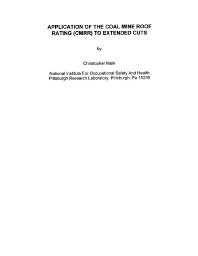Mining Publication: Application of the Coal Mine Roof Rating (CMRR) to Extended Cuts
Original creation date: April 1999
Since it was first introduced, the Coal Mine Roof Rating (CMRR) has been widely accepted as a tool for geologic characterization and mine planning. This paper discusses the application of the CMRR to another practical ground control problem. Extended cuts (cuts greater than 6 m (20 ft) in length) are commonly used with remote control continuous miners. Extended cuts can greatly increase productivity, but they have been associated with a number of fatal roof fall accidents. When extended cuts are attempted in weak roof, the roof may collapse before it can be bolted, causing hazardous conditions. Until now, it has not been possible to predict where conditions may not be suitable for extended cuts. In this study, data on the CMRR and extended cut experience were collected at 36 mines in 7 states. It was found that when the CMRR was greater than 55, deep cuts were routine in nearly every case. When the CMRR was less than 37, extended cuts were almost never taken. Between 38 and 55, extended cuts were feasible sometimes but not others. The data also shows that extended cuts are less likely to be stable if either the entry span or the depth of cover increases.
Authors: C Mark
See Also
- Development and Application of the Coal Mine Roof Rating (CMRR)
- Dynamic Failure in Deep Coal: Recent Trends and a Path Forward
- Engineering Considerations and Selection Criteria for Proximity Warning Systems for Mining Operations
- Factors Influencing Intersection Stability in U.S. Coal Mines
- Geologic Characterization
- Make it Safer with Roof Screen
- New Developments with the Coal Mine Roof Rating
- Optimizing Secondary Roof Support with the NIOSH Support Technology Optimization Program (STOP)
- Overview of Coal Mine Ground Control Issues in the Illinois Basin
- Roof Screening: Best Practices and Roof Bolting Machines
- Technology News 483 - Safety Training Tools for Rock Scaling Personnel
- Content source: National Institute for Occupational Safety and Health, Mining Program


 ShareCompartir
ShareCompartir
